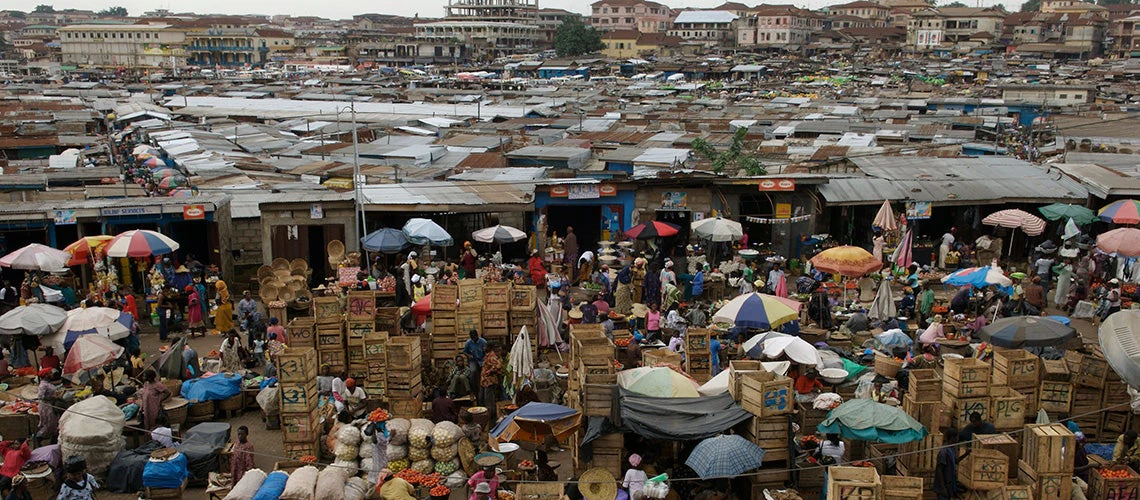 Overlooking a central market. | Photo: © Jonathan Ernst / World Bank
Overlooking a central market. | Photo: © Jonathan Ernst / World Bank
Since 2013, the World Bank has enshrined promoting shared prosperity as one of its twin goals, alongside the elimination of extreme poverty. The shared prosperity goal “…seeks to increase sensitivity to distributional issues, shifting the common understanding of development progress away from average per capita income and emphasizing that good growth should benefit the least well-off in society.” (World Bank (2015), p.10). The World Bank tracks shared prosperity by monitoring growth in average incomes in the bottom 40 percent of the income distribution in all countries. This measure has a certain intuitive appeal. But it also has three significant shortcomings:
- First, growth in the bottom 40 percent “…tells us nothing at all about how rising prosperity — or economic contraction — is being shared among the poorest 40 percent”, as the late Martin Ravallion put it in a 2015 blog. Worse, growth in the bottom 40 percent actually gives greater weight to the richest within this group, and negligible weight to the poorest. Why? Because a percentage point of growth raises the income of a richer person by a larger absolute amount than it raises the income of a poorer person.
- Second, focusing on the bottom 40 percent of each country leaves out many people who are relatively well-off in their countries but are still very poor by any reasonable global standard. For example, a person in Mali earning $5.50 per day would have been in the top third of Malians but in the bottom 40 percent of the world income distribution in 2019. Conversely, someone in Peru earning $8.50 per day would be in the bottom 40 percent of Peru’s income distribution, but in the top half of the world income distribution. Using growth in the bottom 40 percent at the country level as a measure of shared prosperity means that growth in the income of the Malian would not count as boosting shared prosperity, while growth in income for the Peruvian would count.
- Third, there is no global metric to measure shared prosperity in the same units as at the country level. This is a simple consequence of the previous shortcoming: being in the bottom 40 percent of the world does not mean you are in the bottom 40 percent of your country, and vice versa. The lack of a global “headline” number for shared prosperity analogous to the global extreme poverty headcount has limited the appeal, and likely the impact, of this measure.
The global prosperity gap
Can we have a measure of shared prosperity that unambiguously rewards growth among the poorest? That makes sense both at the country level and at the global level? That is as easy to understand and to explain as growth in the bottom 40 percent? In a new paper (Kraay ⓡ al. (2023)), we propose such a measure: the global prosperity gap. It measures the global average shortfall in income from a standard of prosperity set at $25 per day (adjusted for differences in purchasing power parity across countries). It is defined as the average factor by which incomes need to be multiplied to bring everyone in the world to the prosperity standard.
The prosperity gap is based on the ratio , where
per day is the prosperity standard, and
is the income of individual
For a person whose income is $2.50 per day, this ratio is 10, meaning that their income would have to increase by a factor of 10 to reach the prosperity standard. Similarly, for a person with income equal to $5 per day, this ratio is 5, meaning that their income would have to increase by a factor of five. For a person with income equal to $25 per day, the ratio is equal to one, meaning no increase is needed to reach the prosperity standard. The prosperity gap is simply the average of these ratios across all people: the average factor by which incomes must be multiplied to attain the prosperity standard of $25 per day. This measure unambiguously gives greater weight to poorer people. The poorest person with daily income equal to $2.50 gets twice the weight of a person with twice the income (at $5.00), and ten times the weight of a person with ten times higher income (at $25).
How has the world done in narrowing the prosperity gap? In 1990, the prosperity gap for the world as a whole was 10.8, meaning that incomes would on average have to increase nearly 11-fold to reach the prosperity standard of $25 per day. By 2019 the prosperity gap had fallen to 5, meaning that incomes would on average have to increase five-fold to reach the prosperity standard. (Figure 1).
Figure 1: The global prosperity gap
Notes: This figure reports the global estimate of the prosperity gap using the prosperity standard of $25 per person per day in 2017 $PPP for the period 1990 to 2019. Use the dropdown menu on top of the chart to choose the trends using different prosperity standards.
A truly pro-poor measure of growth
The easiest way to see the difference between prosperity gap reductions and income growth in the bottom 40 percent as a measure of shared prosperity is to ask the question “whose growth matters?”. The answer is shown in Figure 2.
The panel on the left shows what happens if we use growth in the bottom 40 percent of each country as the measure of shared prosperity, using Mali, Peru, and France as examples. The graph shows how much growth at each income level matters for shared prosperity. Within each country, the upward-sloping part of the line shows that growth among the richest of the bottom 40 percent matters more for shared prosperity than growth among the poorest (the first problem noted above). At the same time, the flat part of the line shows that no one in the top 60 percent of Mali’s income distribution boosts shared prosperity by increasing their income, even though many people in this group are poorer than most people in Peru and nearly everyone in France (the second problem noted above). And similarly, growth in the top 60 percent of the income distribution of Peru and France also does not matter for shared prosperity.
The panel on the right shows that things are very different if we use the prosperity gap to measure shared prosperity. The prosperity gap falls fastest when growth is concentrated among the poorest, no matter where in the world they live. Growth among Malians on average matters more for reductions in the prosperity gap than growth among Peruvians or among the French. And within each country, growth of the poor matters more than growth of the rich. Giving greater weight to growth of the poorest, wherever they live, captures the spirit of promoting shared prosperity and addresses the first two shortcomings of the current measure of shared prosperity.
Figure 2. Whose growth matters for shared prosperity?
Image

Notes: This figure shows how growth at different income levels matters for shared prosperity, measured using growth in the bottom 40 percent (left panel) and reductions in the prosperity gap (right panel).
The prosperity gap for people, countries, regions, and the world
For each person, the prosperity gap is the factor by which their income must be multiplied to reach the prosperity standard of $25 per day. For each country, the prosperity gap is just the average of this factor across everyone in the country. For regions, the prosperity gap is just the population-weighted average of countries in the region, and similarly for the world. This feature allows us to seamlessly aggregate and disaggregate shared prosperity for subgroups, using the same simple intuitive units: the average factor by which incomes must increase to reach the prosperity standard of $25 per day. This feature of the prosperity gap fixes the third shortcoming of growth in the bottom 40 percent discussed at the start of this blog.
Figure 3 shows the regional contributions to the global prosperity gap over time. East Asia, South Asia, and Sub-Saharan Africa were the largest contributors to the prosperity gap in 2019 – the first two because of their high share of world population and the latter due to very low incomes. While the contributions of East and South Asia to the global prosperity gap have dramatically reduced since 1990, the contribution of Sub-Saharan Africa has barely changed in 30 years.
Figure 3. Regional contributions to the global prosperity gap
Image

Notes: This figure decomposes the global prosperity gap into contributions by regions using the prosperity threshold of $25 per person per day in 2017 $PPP.
Why $25 per day?
The $25 per day prosperity standard can be justified in several ways. First, it is slightly above average daily household per capita income at the point where countries reach high-income status, according to the World Bank’s income classification (at $23 per day). Second, it is also slightly above the typical poverty line in high-income countries (at $24 per day). Finally, there is some communications value in having a nice round number such as $25 per day as the standard.
Of course, reasonable people can disagree on what “prosperity” means in dollar terms. An appealing feature of the prosperity gap is that it is simple to move between different standards of prosperity: we just need to scale the prosperity gap up or down by for any alternative prosperity threshold
. For example, one could make the case that escaping poverty by the standards of upper-middle-income countries counts as “prosperity”, corresponding to a prosperity standard of $6.85 per day. To convert the $25 per day prosperity gap of 5 in 2019 to this new standard, all we need to do is multiply it by 6.85/25=0.27 to get a prosperity gap of 1.4. That means, on average, that incomes need to increase by a factor of just 1.4 to reach the more meager prosperity standard of $6.85. Changing the prosperity standard just changes the units of the prosperity gap. It does not change the fact that the prosperity gap rewards growth of the poor much more than growth of the rich, independent of the choice of the prosperity standard,
.
How much do growth and reductions in inequality matter for boosting shared prosperity?
A very useful feature of income growth in the bottom 40 percent is that it is easy to separate out the contributions of growth and changes in inequality to improvements in shared prosperity. This is because growth in the bottom 40 percent is just the sum of growth in average incomes and growth in the income share of the bottom 40 percent (a measure of reduced inequality).
The prosperity gap shares this attractive feature, but with a new and intuitive measure of inequality that we also introduce in our paper (Kraay ⓡ al. (2023)). The inequality measure is simply the average factor by which incomes must increase in order to attain average income, recognizing that this factor is below one for everyone whose income is above the average. The rate of improvement in the prosperity gap is just the sum of growth in average incomes and the rate of decline in this new measure of inequality. For the world as a whole, the decline in the prosperity gap from 10.8 to 5 between 1990 and 2019 corresponds to an average annual rate of improvement of 2.7 percent per year. Of this, 1.5 percent per year was due to growth in average incomes, and 1.2 percent per year was due to reduced global interpersonal income inequality (which was mostly due to reductions in between-country inequality, as can be seen in this companion blog in Development Impact).
From indicators to goals
The proposed global prosperity gap is well-suited to be global headline indicator of shared prosperity. It is, however, only an indicator. For it to become a goal, a target for that indicator is needed, together with a timeframe for meeting the goal. For example, an aspirational goal could be halving the prosperity gap from its current level of 5.0 to 2.5 by 2050. Figure 4 shows that reaching this goal would require income growth over the next quarter century that is roughly 2 percentage points faster than the average annual historical growth observed between 2010 and 2019, for each country. In contrast, if historical average growth rates continue into the future, the prosperity gap will decline to just 3.7 by 2050. But if growth is skewed further towards the world’s poor than it has been in the past, the prosperity gap will fall faster. As we have already noted above, the prosperity gap can equally well be measured at the country level and can be used to set goals for improvements in shared prosperity at the country level, too.
Figure 4. The prosperity gap — past and possible futures
Image
Note: The prosperity standard is $25 per person per day (2017 PPPs). The baseline target is defined as reducing the prosperity gap from 5.0 in 2019 to 3.7 in 2050. The aspirational target is defined as roughly halving the 2019 prosperity gap from 5.0 to 2.5 in 2050. Historical growth rate is each country’s average growth observed between 2010-2019.
There are many ways to measure how prosperity is shared across different people and different groups in society. These include the average income growth in the bottom 40 percent — the measure currently monitored by the World Bank — but also measures of inequality at country and global levels, and measures of differences in well-being and opportunity across social groups, to name just a few. The prosperity gap is an attractive new measure of shared prosperity. It is simple, easy to understand, and straightforward to estimate. The prosperity gap also has two unique features, which we highlight in this blog. First, it is truly distribution sensitive, giving more weight to growth in the incomes of the poorest individuals. It therefore better reflects global concerns for the poorest, and for reducing inequality. Second, the global measure can be easily aggregated and disaggregated at different levels, making it a useful tool for measuring shared prosperity within countries, at the country level, and at the global level, all in the same simple intuitive units.
Want to learn more about the technical properties of the prosperity gap, and about tools to help to calculate and analyze it? See our companion blog over on Development Impact.
_______________








Join the Conversation